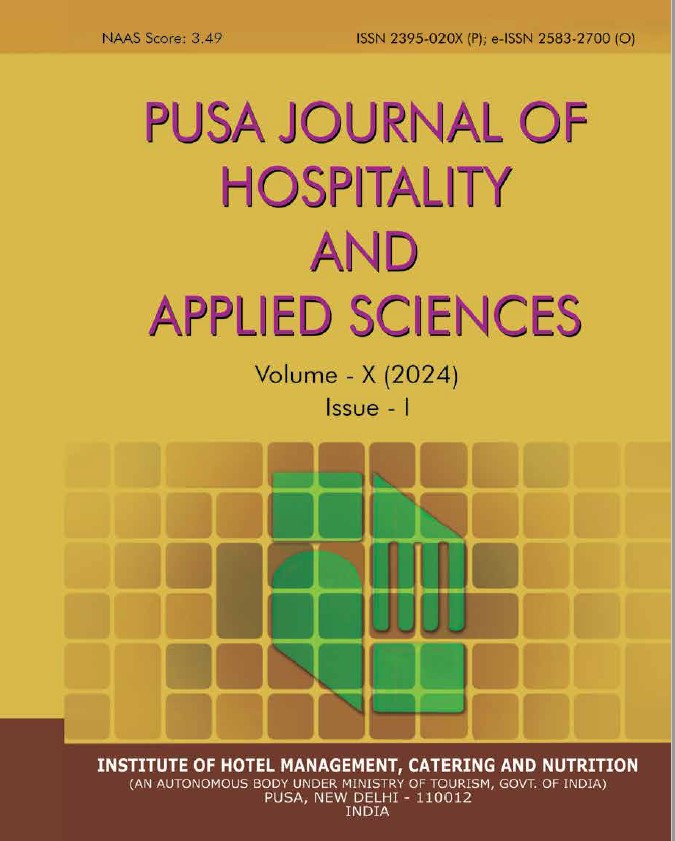From Intention to Action: Factors Shaping Tourist Decisions to Experience Local Food
DOI:
https://doi.org/10.48165/pjhas.2025.11.1.3Keywords:
Tourist behaviour, local food, theory of planned behaviour, culinary tourism, food samplingAbstract
Background: Culinary tourism enhances travel experiences by allowing tourists to engage with local cultures through food. Understanding the factors influencing tourists’ decisions to sample and purchase local food is crucial for destination marketers. Objective: This study examines the relationships between Tourist Attitude Towards Local Food (TALF), Tourist Subjective Norms (TSN), Tourist Perceived Behavioural Control (TPBC), Tourist Intention to Sample Local Food (TISLF) and Tourist Decision to Purchase Local Food (TDPLF) in Nainital, India. Methodology: The study adopted a quantitative research design and was conducted in Nainital, a popular tourist destination in Uttarakhand, India. A structured questionnaire was used to collect data from 450 domestic tourists using convenience sampling. Data were analysed using Structural Equation Modeling (SEM) and path analysis through PLS-SEM to assess relationships among key variables and test the proposed hypotheses. Results: TALF, TSN and TPBC significantly influence TISLF, which, in turn, positively affects TDPLF. Social influence, perceived control and positive attitudes shape tourists’ food choices, with food sampling playing a key role in purchasing decisions. Conclusion: The study highlights the importance of social influence, accessibility and cultural authenticity in enhancing culinary tourism. Strengthening these aspects can boost Nainital’s appeal as a gastronomic destination.References
Aitken, R., Watkins, L., Williams, J., & Kean, A. (2020). The positive role of labelling on consumers perceived behavioural control and intention to purchase organic food. Journal of Cleaner Production, 255, 120334. https://
doi.org/https://doi.org/10.1016/j.jclepro.2020.120334
Ajzen, I. (1991). The theory of planned behavior. Organizational Behavior and Human Decision Processes, 50(2), 179–211. https://doi.org/10.1016/0749- 5978(91)90020-T
Atsız, O., Cifci, I., & Rasoolimanesh, S. M. (2022). Exploring the components of meal-sharing experiences with local foods: A netnography approach. Current Issues in Tourism, 25(6), 919–936.
BalıkçıoğluDedeoğlu, S., Eren, D., Sahin Percin, N., & Aydin, Ş. (2022). Do tourists’ responsible behaviors shape their local food consumption intentions? An examination via the theory of planned behavior. International Journal of Contemporary Hospitality Management, 34(12), 4539– 4561.
Barbhuiya, M. R. (2021). Overtourism in Indian cities: a case study of Nainital. International Journal of Tourism Cities, 7(3), 702–724.
Baysse-Lainé, A., & Perrin, C. (2018). How can alternative farmland management styles favour local food supply? A case study in the Larzac (France). Land Use Policy, 75, 746–756. https://doi.org/10.1016/j.
landusepol.2018.03.012
Bentler, P. M., & Bonett, D. G. (1980). Significance tests and goodness of fit in the analysis of covariance structures. Psychological Bulletin, 88(3), 588–606. https://doi. org/10.1037/0033-2909.88.3.588
Bhakuni, K. (2017). Issues and challenges of sustainable tourism in Nainital, Uttarakhand.
Brown, T. A. (2015). Confirmatory factor analysis for applied research. Guilford publications. Sustainable Smart Cities in India: Challenges and Future Perspectives, 383–397.
Cai, L., Chung, S. W., & Lee, T. (2023). Incremental model fit assessment in the case of categorical data: Tucker–Lewis
Okoye, K., & Hosseini, S. (2024). Chi-Squared (X2) Statistical Test in R. In R Programming: Statistical Data Analysis in Research (pp. 211–223). Springer.
Pamukçu, H., Saraç, Ö., Aytuğar, S., &Sandıkçı, M. (2021). The effects of local food and local products with geographical indication on the development of tourism gastronomy. Sustainability, 13(12), 6692.
Park, E., &Widyanta, A. (2022). Food tourism experience and changing destination foodscape: An exploratory study of an emerging food destination. Tourism Management Perspectives, 42, 100964.
Peral-Peral, B., Arenas Gaitán, J., & Reina-Arroyo, J. (2022). Buying local food is not a question of attitude: an analysis of benefits and limitations. Spanish Journal of Marketing - ESIC, 26(1), 80–97. https://doi.org/10.1108/
SJME-09-2021-0181
Purwanto, A. (2021). Partial least squares structural squation modeling (PLS-SEM) analysis for social and management research: a literature review. Journal of Industrial Engineering & Management Research.
Qi, X., & Ploeger, A. (2021). Explaining Chinese consumers’ green food purchase intentions during the COVID-19 pandemic: An extended Theory of Planned Behaviour. Foods, 10(6), 1200.
Rehman, S. U., Samad, S., Singh, S., & Usman, M. (2022). Tourist’s satisfaction with local food effect behavioral intention in COVID-19 pandemic: a moderated-mediated perspective. British Food Journal, 124(10), 3133–3151.
Rendall, S., Harvey, K., Tavassoli, T., & Dodd, H. (2022). Associations between emotionality, sensory reactivity and food fussiness in young children. Food Quality and Preference, 96, 104420. https://doi.org/https://doi.
org/10.1016/j.foodqual.2021.104420
Roh, T., Seok, J., & Kim, Y. (2022). Unveiling ways to reach organic purchase: Green perceived value, perceived knowledge, attitude, subjective norm and trust. Journal of Retailing and Consumer Services, 67, 102988.
Shen, C., Panda, S., & Vogelstein, J. T. (2022). The chi-square test of distance correlation. Journal of Computational and Graphical Statistics, 31(1), 254–262.
Shi, D., DiStefano, C., Maydeu-Olivares, A., & Lee, T. (2022). Evaluating SEM model fit with small degrees of freedom. Multivariate Behavioral Research, 57(2–3), 179–207.
Shi, D., & Maydeu-Olivares, A. (2020). The effect of estimation methods on SEM fit indices. Educational and
Psychological Measurement, 80(3), 421–445.
Shrestha, N. (2021). Factor analysis as a tool for survey analysis. American Journal of Applied Mathematics and Statistics, 9(1), 4–11.
Singh, U. K., Gautam, N., Bhandari, T. R., & Sapkota, N. (2020). Educational intervention of intention change for consumption of junk food among school adolescents in Birgunj metropolitan city, Nepal, based on theory of planned behaviors. Journal of Nutrition and Metabolism,
2020(1), 7932324.
Sogari, G., Pucci, T., Caputo, V., & Van Loo, E. J. (2023). The theory of planned behaviour and healthy diet: Examining the mediating effect of traditional food. Food Quality and Preference, 104, 104709.
Soltani, M., Soltani Nejad, N., Taheri Azad, F., Taheri, B., & Gannon, M. J. (2021). Food consumption experiences: a framework for understanding food tourists’ behavioral intentions. International Journal of Contemporary Hospitality Management, 33(1), 75–100.
Stalmirska, A. M. (2021). Local Food in Tourism Destination Development: The Supply-Side Perspectives. Tourism Planning & Development, 1–18. https://doi.org/10.108 0/21568316.2021.1928739
Stalmirska, A. M. (2024). Local food in tourism destination development: The supply-side perspectives. Tourism Planning & Development, 21(2), 160–177.
Sultan, P., Tarafder, T., Pearson, D., & Henryks, J. (2020). Intention-behaviour gap and perceived behavioural control-behaviour gap in theory of planned behaviour: Moderating roles of communication, satisfaction and trust in organic food consumption. Food Quality and Preference, 81, 103838.
Tucker, L. R., & Lewis, C. (1973). A reliability coefficient for maximum likelihood factor analysis. Psychometrika, 38(1), 1–10.
Van Tonder, E., Fullerton, S., De Beer, L. T., & Saunders, S. G. (2023). Social and personal factors influencing green customer citizenship behaviours: The role of subjective norm, internal values and attitudes. Journal of Retailing and Consumer Services, 71, 103190.
Wang, O., & Scrimgeour, F. (2021). Willingness to adopt a more plant-based diet in China and New Zealand: Applying the theories of planned behaviour, meat attachment and food choice motives. Food Quality and Preference, 93, 104294.




